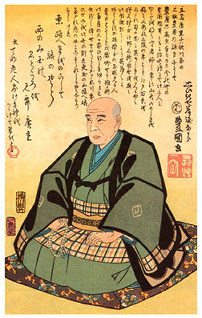東海道五十三次のヘッダー
Tokaido Goju-san Tsugi
"Tokaido Goju-san Tsugi," an anthology of landscape masterpieces by Utagawa Hiroshige

Utagawa Hiroshige
(1797-1858)
The Tokaido Highway, which started from Nihonbashi in Edo (today's Tokyo) and terminated at Sanjo Ohashi in Kyoto, covered a total distance of 126 ri, six cho and one ken (approximately 492 km). It was just 400 years ago that the Tokaido became fully equipped as a major highway. After winning the famous battle of Sekigahara in 1600, Tokugawa Ieyasu, founder of the Tokugawa Shogunate, inaugurated what was known as the tenma-sei (post-horse system) as one of the many administrative measures that he took to establish the feudal government system. The tenma system was designed to set up post towns along major highways in order to provide manpower and horses to facilitate the mobility of government officials as well as the physical flow of goods and the dissemination of information. Under this system, 53 post towns were created along the Tokaido Highway.

Click to enlarge
What made travel along the Tokaido Highway increasingly popular among the general public was "Tokaidochu Hizakurige," a comical travelogue written by playwright Juppensha Ikku, and the serialized woodblock landscape prints produced by ukiyoe artist Utagawa (Ando) Hiroshige under the title of "Tokaido Goju-san Tsugi." It was in 1832 that Hiroshige set out on his first trip to Kyoto along the Tokaido Highway. A distinguished series of 55 works, born of his observations and experiences, conveys the atmosphere and sentiment prevailing in each post town on the highway. Moreover, the 55 works portray beautifully in fine detail the harmony between man and nature. For instance, they describe seasonal changes as seen in the mist in spring, showers in summer, clear blue skies in autumn and snow in winter, by delineating delicate features ranging from the morning glow to sunset. These works bespeak the close attention that Hiroshige paid to every minute detail in depicting the movements and facial expressions of the people who appear in his pictures, such as samurai warriors, townspeople and workmen.
The "seven" mentioned in the line from an old popular song, "Starting at seven from Nihonbashi, Edo" is "four o'clock in the morning" in modern terms. Old-time travelers started before dawn so as to arrive at the next post town before sunset. Hiroshige's masterpieces depicting the landscapes along the old Tokaido Highway are reminiscent of the leisurely travel that people enjoyed in the olden days when time moved slowly and people were not in a hurry. This is a complete set of Hiroshige's landscape woodblock prints depicting 53 post towns on the Tokaido Highway to which the pictures of Nihonbashi in Edo and Sanjo Ohashi in Kyoto are added, all reproduced on hand-made washi paper. It is hoped that you will enjoy the individual charm of each picture.